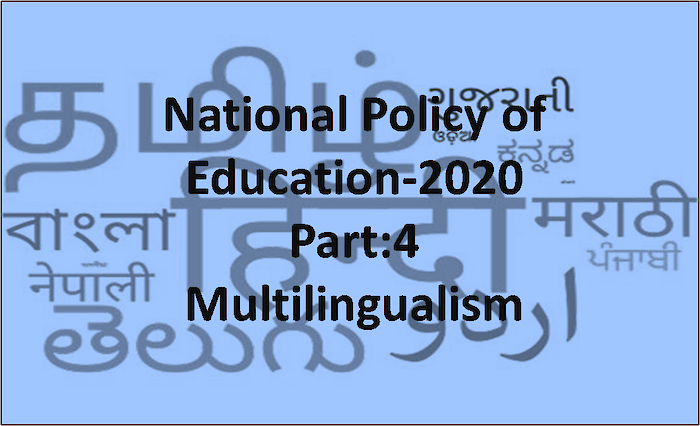In the series of my blogs about National Policy of Education 2020, I am going to discuss about the next important aspect of the policy which is debated the most i.e. introduction of multilingualism. Before going into details listed in policy I would like to write about what is the Multilingualism.
What is multilingualism?
Learning two (or more) languages at the same time is known as multilingualism.
What are the benefits of learning multiple languages at a time? Is there any disadvantages in being multilingual? These are the important aspects which are going to be addressed before diving into the details enlisted in the policy.
Advantages of being Multilingual:
- Many developmental benefits are known in learning multiple languages at an early age. Improved executive functioning skills—the ability to think flexibly, demonstrate self-control, focus attention, and tune out distractions (Bialystok & Martin, 2004; Zelazo, Carlson, & Kesek, 2008) were seen in kids who learnt more than one language.
- Bilingual children were found to have better working memory than children who speak only one language (Morales, Calvo, & Bialystok, 2013). What is working memory? Working memory is a cognitive system with a limited capacity that temporarily hold information. Working memory is important for reasoning and the guidance of decision-making and behaviour. Working memory allows for the manipulation of stored information. So these children will be better at problem solving and other executive functions.
- The differences between multilingual and single-language speakers exist even at the neural level. Research has found that the patterns of brain response of multilingual infants to speech are different from those of infants whose families speak only one language. Multilingual children show continuous improvement in discriminating between the languages.
Now whomsoever may argue I am wrong, sorry I have realised all these advantages in my child. She was exposed to 5 different languages in her early years. I spoke to her in Tamizh (I prefer writing in this fashion rather than Tamil as the sound "zh" is the beauty of Tamizh), my husband spoke in Malayalam, in her creche she was exposed to Hindi and Marathi and in School , English. When she was an Infant, everyone around us were telling us not to confuse her with multiple languages. They said she won't be able to learn any one language properly. But we were adamant. We were sure that she would pick up all the languages equally. NOw she is 10 year old. She can speak in 4 languages (Tamizh, Malayalam, Hindi and English) fluently and Marathi she could understand well, maybe she will start speaking given an opportunity. She never had any confusion. Now,when she tries to speak in a language she never mixes the words from another language which she initially did which normally everyone would do. Apart from being multilingual she is good at remembering things. She is good at studies too. She learnt all the languages effortlessly as she was exposed at an early stage. She is good at reading and writing English and Hindi. Now she has taken interest to read and write Tamizh and Malayalam too. So, I am vouching for being multilingual is good for the child in its growth and development. Also it is known that at young age children can learn multiple languages easily than when they are grown up. I can relate this situation of learning languages in adulthood being difficult based on my own experience. I myself being multilingual learnt Telugu, Malayalam, kannada and Hindi during my college days. I could learn only because I took keen interest and efforts in learning them. I had to really work hard for learning and it was only possible because I was in hostel residing with people who spoke these languages. I had always enjoyed the advantages of learning multiple languages in my adulthood. So being multilingual is always an advantageous one.
None of the studies have shown any disadvantages in being multilingual or children being exposed to multiple languages at an early stage.
Now let me enlist the details in the policies.
- Wherever possible, the medium of instruction until at least Grade 5, but preferably till Grade 8 and beyond, will be the home language/mother-tongue/local language. Thereafter, the home/local language shall continue to be taught as a language wherever possible. This will be followed by both public and private schools.
- High-quality textbooks, including in science, will be made available in home languages.
- In cases where home-language textbook material is not available, the language of the interaction between teachers and students will still remain the home language wherever possible.
- Teachers will be encouraged to use a bilingual approach, including bilingual teaching-learning materials, with those students whose home language may be different from the medium of instruction.
- All languages will be taught with high quality; a language does not need to be the medium of instruction for it to be learned well.
- All languages will be taught in an enjoyable and interactive style.
- Early reading and subsequently writing in the mother tongue in the early years – with skills developed for reading and writing in the other two languages in Grade 3 and beyond.
- All language learning will aim to be experiential and enhanced through art, such as music, poetry, and theatre.
- There will be a major effort from both the Central and State governments to invest in large numbers of language teachers in all regional languages around the country, and in particular all Schedule 8 languages.
- States, especially states from different regions of India, may enter bilateral agreements to hire teachers in large numbers from each other, to satisfy the three-language formula in their respective states, and also to encourage the study of Indian languages across the country.
- Students whose medium of instruction is the local/home language will begin to learn science and mathematics, bilingually in Grade 6 so that by the end of Grade 9 they can speak about science and other subjects both in their home language and English. This is a very important aspect as many students who learn in other than English medium schools find it difficult to express their ideas in the global platforms. People may argue about many who have achieved a lot in their life after studying in non-English medium schools. What we must remember is they are only handful of people who were self motivated. It's not possible that every talented child is self motivated to express themselves confidently in the global platform without having fluency in English. Many students who study in non-English medium schools suffer in their higher education where all the terminologies are in English. To achieve this bilingual teaching high-quality bilingual textbooks and teaching-learning materials will be prepared.
Only things which needs to be seen is how this policy is being implemented. Many teachers if not all in government schools are not well versed in English themselves. So first training these teachers in spoken english is very important. I don't know if Government is having any plans regarding this important aspect. Many teachers were found unable to read and write in english. They never felt the importance of learning English all these years. So, reorienting them and making them analyse the importance is going to be a big task in itself. Only if you can train them you can bring about the changes mentioned in the policy. So government should think of these aspects and start training them sooner. Otherwise the policy will remain only in papers. I will continue writing about other aspects of multilingualism in the policy in my next part of the series.
[ A total of 54 Likes and 56 Loves for this article. Please caste your vote.!! ]
Comment What You Think






